R で%*%演算子を使用する

%*%演算子は、行列の乗算に使用されます。同じ長さのベクトルでは、この演算子は内積を与えます。
この記事では、いくつかの簡単な例を使用して、この演算子の使用法について説明します。
R での行列とその次元
行列は、数値の長方形の配列です。これは、行と列を持つ数値の表のようなものです。
次のコードは、同じ 12 個の数値を使用して 4つの行列を作成して表示します。
サンプルコード:
# First, we will create a vector of numbers.
# These 12 numbers are what we will place in our matrices.
v = 7:18
# Matrix with 2 rows and 6 columns.
matrix(v, nrow=2)
dim(matrix(v, nrow=2))
# Matrix with 3 rows and 4 columns.
matrix(v, nrow=3)
dim(matrix(v, nrow=3))
# Matrix with 4 rows and 3 columns.
matrix(v, nrow=4)
dim(matrix(v, nrow=4))
# Matrix with 6 rows and 2 columns.
matrix(v, nrow=6)
dim(matrix(v, nrow=6))
出力:
> # Matrix with 2 rows and 6 columns.
> matrix(v, nrow=2)
[,1] [,2] [,3] [,4] [,5] [,6]
[1,] 7 9 11 13 15 17
[2,] 8 10 12 14 16 18
> dim(matrix(v, nrow=2))
[1] 2 6
> # Matrix with 3 rows and 4 columns.
> matrix(v, nrow=3)
[,1] [,2] [,3] [,4]
[1,] 7 10 13 16
[2,] 8 11 14 17
[3,] 9 12 15 18
> dim(matrix(v, nrow=3))
[1] 3 4
> # Matrix with 4 rows and 3 columns.
> matrix(v, nrow=4)
[,1] [,2] [,3]
[1,] 7 11 15
[2,] 8 12 16
[3,] 9 13 17
[4,] 10 14 18
> dim(matrix(v, nrow=4))
[1] 4 3
> # Matrix with 6 rows and 2 columns.
> matrix(v, nrow=6)
[,1] [,2]
[1,] 7 13
[2,] 8 14
[3,] 9 15
[4,] 10 16
[5,] 11 17
[6,] 12 18
> dim(matrix(v, nrow=6))
[1] 6 2
上で作成した各マトリックスには、異なる数の行と列がありました。
行列は、その行と列の数で表されます。これはその次元と呼ばれます。m 行と n 列を持つ行列は、m x n 行列と呼ばれ、mxn として読み取られます。
作成したマトリックスの次元は、2x6、3x4、4x3、および 6x2 でした。
%*%演算子を使用して R の行列を乗算する
行列の乗算は、最初の行列の列番号が 2 番目の行列の行数と等しい場合にのみ定義されます。この条件が満たされると、%*%演算子を使用してこれら 2つの行列をこの順序で乗算でき、その積も行列になります。
積行列には、最初の行列と同じ数の行と 2 番目の行列と同じ数の列があります。
サンプルコード:
# First, we will create two matrices for which multiplication is defined.
Ist = matrix(v, ncol=3)
Ist
IInd = matrix(v, nrow=3)
IInd
# Find the product matrix.
Ist %*% IInd
出力:
> # First, we will create two matrices for which multiplication is defined.
> Ist = matrix(v, ncol=3)
> Ist
[,1] [,2] [,3]
[1,] 7 11 15
[2,] 8 12 16
[3,] 9 13 17
[4,] 10 14 18
> IInd = matrix(v, nrow=3)
> IInd
[,1] [,2] [,3] [,4]
[1,] 7 10 13 16
[2,] 8 11 14 17
[3,] 9 12 15 18
> # Find the product matrix.
> Ist %*% IInd
[,1] [,2] [,3] [,4]
[1,] 272 371 470 569
[2,] 296 404 512 620
[3,] 320 437 554 671
[4,] 344 470 596 722
有効な行列乗算の別の例と、行列乗算が定義されていない 2つの例を見ていきます。
サンプルコード:
# A 3 x 2 matrix.
IInd_b = matrix(20:25, nrow=3)
IInd_b
# A 2 x 6 matrix.
Ist_b = matrix(v, nrow=2)
Ist_b
# Matrix multiplication is defined between Ist and IInd_b.
Ist %*% IInd_b
# Multiplication is NOT defined in the following two cases.
IInd_b %*% Ist
Ist_b %*% IInd_b
出力:
> # A 3 x 2 matrix.
> IInd_b = matrix(20:25, nrow=3)
> IInd_b
[,1] [,2]
[1,] 20 23
[2,] 21 24
[3,] 22 25
> # A 2 x 6 matrix.
> Ist_b = matrix(v, nrow=2)
> Ist_b
[,1] [,2] [,3] [,4] [,5] [,6]
[1,] 7 9 11 13 15 17
[2,] 8 10 12 14 16 18
> # Matrix multiplication is defined between Ist and IInd_b.
> Ist %*% IInd_b
[,1] [,2]
[1,] 701 800
[2,] 764 872
[3,] 827 944
[4,] 890 1016
> # Multiplication is NOT defined in the following two cases.
> IInd_b %*% Ist
Error in IInd_b %*% Ist : non-conformable arguments
> Ist_b %*% IInd_b
Error in Ist_b %*% IInd_b : non-conformable arguments
R でベクトルの内積を得るために %*% 演算子を使用する
ベクトルは、その長さとクラス(およびタイプ)によって記述されます。
サンプルコード:
# Create a vector.
vtr = c(11,22,33)
# Check that it is a vector.
is.vector(vtr)
# Length of the vector.
length(vtr)
# Class of the vector.
class(vtr)
# Type of the vector.
typeof(vtr)
出力:
> # Create a vector.
> vtr = c(11,22,33)
> # Check that it is a vector.
> is.vector(vtr)
[1] TRUE
> # Length of the vector.
> length(vtr)
[1] 3
> # Class of the vector.
> class(vtr)
[1] "numeric"
> # Type of the vector.
> typeof(vtr)
[1] "double"
ベクトルの長さは、その中の要素(数)の数です。
%*%演算子を使用して同じ長さの 2つのベクトルを乗算すると、ベクトルの内積が得られます。R は、最初のベクトルを行行列として、2 番目のベクトルを列行列として暗黙的に扱い、積行列を提供します。
スカラーではなく 1x1 行列を返します。これは、is.vector() および is.matrix() 関数を使用して確認できます。
次のコードでは、最初に同じ長さの 2つのベクトル間の内積を取得します。次に、適合次元の行列を使用して同じ結果を取得します。
サンプルコード:
# Four-element vectors.
V_I = 22:25
V_II = 2:5
# Dot product of vectors of the same dimension.
V_I %*% V_II
# Check the input and output.
is.vector(V_I)
is.matrix(V_I)
is.vector(V_I %*% V_II)
is.matrix(V_I %*% V_II)
# Create matrices of conformable dimensions (where matrix multiplication is defined).
m_I = matrix(V_I, nrow=1)
m_I
m_II = matrix(V_II, ncol=1)
m_II
# Matrix product.
m_I %*% m_II
出力:
> # Four-element vectors.
> V_I = 22:25
> V_II = 2:5
> # Dot product of vectors of the same dimension.
> V_I %*% V_II
[,1]
[1,] 334
> # Check the input and output.
> is.vector(V_I)
[1] TRUE
> is.matrix(V_I)
[1] FALSE
> is.vector(V_I %*% V_II)
[1] FALSE
> is.matrix(V_I %*% V_II)
[1] TRUE
> # Create matrices of conformable dimensions (where matrix multiplication is defined).
> m_I = matrix(V_I, nrow=1)
> m_I
[,1] [,2] [,3] [,4]
[1,] 22 23 24 25
> m_II = matrix(V_II, ncol=1)
> m_II
[,1]
[1,] 2
[2,] 3
[3,] 4
[4,] 5
> # Matrix product.
> m_I %*% m_II
[,1]
[1,] 334
ベクトルの長さが異なる場合、内積を計算することはできません。
サンプルコード:
# A three-element vector.
V_II_b = 6:8
# Dot product is not possible.
V_I %*% V_II_b
出力:
> # A three-element vector.
> V_II_b = 6:8
> # Dot product is not possible.
> V_I %*% V_II_b
Error in V_I %*% V_II_b : non-conformable arguments
まとめ
乗算の整合行列の場合、%*%は積行列を返します。同じ長さのベクトルの場合、ドット積を 1x1 行列として返します。
